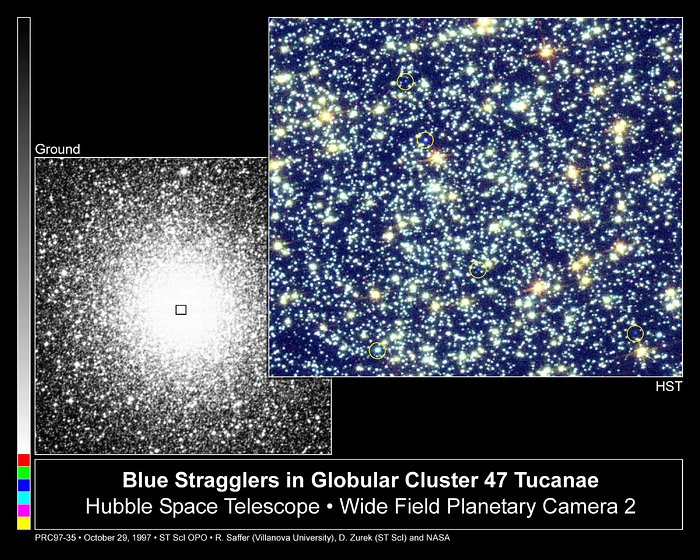Blue Stragglers in Globular Cluster 47 Tucanae
The core of globular cluster 47 Tucanae is home to many blue stragglers, rejuvenated stars that glow with the blue light of young stars. A ground-based telescope image (on the left) shows the entire crowded core of 47 Tucanae, located 15,000 light-years away in the constellation Tucana. Peering into the heart of the globular cluster's bright core, the Hubble Space Telescope's Wide Field and Planetary Camera 2 separated the dense clump of stars into many individual stars (image on right). Some of these stars shine with the light of old stars; others with the blue light of blue stragglers. The yellow circles in the Hubble telescope image highlight several of the cluster's blue stragglers. Analysis for this observation centered on one massive blue straggler.
Astronomers theorize that blue stragglers are formed either by the slow merger of stars in a double-star system or by the collision of two unrelated stars. For the blue straggler in 47 Tucanae, astronomers favor the slow merger scenario.
Credit:R. Saffer (Villanova University), D. Zurek (STScI) and NASA/ESA
About the Image
About the Object
| Name: | 47 Tuc, 47 Tucanae, NGC 104 |
|---|---|
| Type: | Milky Way : Star : Grouping : Cluster : Globular |
| Distance: | 15000 light years |
| Category: | Star Clusters |
Colours & filters
| Band | Wavelength | Telescope |
|---|---|---|
| Ultraviolet U | 300 nm |
Hubble Space Telescope
WFPC2 |
| Optical B | 439 nm |
Hubble Space Telescope
WFPC2 |
| Ultraviolet Mid-UV | 215 nm |
Hubble Space Telescope
WFPC2 |
Notes: All observation data refers to the right image, the left image was captured by a ground-based telescope.
